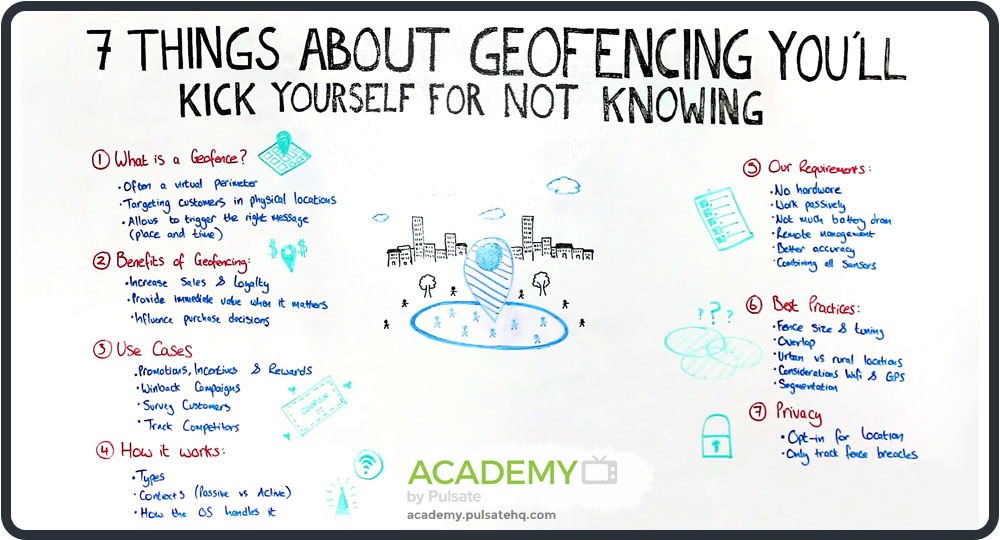When you are considering buying geo-fencing software you need to understand one thing, that not every software company making these tools create them equally.
In our earlier posts, we go over the basics of what a geofence is and we cover some of the best practices that you should consider when using them with your mobile app.
At Pulsate we’ve put a lot of work into understanding how the device and its sensors accurately plot customers entering and leaving these virtual zones.
In this episode we discuss everything that you need to know, the boxes that you need to check to make sure you’re selecting the correct vendor when it comes to geofencing.

1 – SHAPING UP YOUR FENCES
When selecting a location based marketing vendor check that the software can create fences of any shape or size. Many geo-fencing companies currently only allow you to create circles that in some cases, can be the size of a city.
Possibly you only have a need to geofence around your business premises, a specific room within the building, or even geofence a competitor.
Whilst there are some use cases for geo-fencing an entire city and certainly, with a tool like Pulsate Locate™ you can do that, but bear in mind you will need to have the ability to go from the macro and zoom right down into the micro-location of that user.
It’s possible to reduce a geofence down to 20 meters in size with accuracy that doesn’t require you to create circles around specific locations.
But not every location, and in fact, most of them do not conform to being in a neat circle. Being able to draw polygons, triangles, rectangles and any other shape removes any associated limitations related to the geofence size or shape that you wish to monitor.
If you are simply targeting a standalone building or indeed a specific room in that building; you can target users that show up at these locations, or to engage with them in some way.
2 – MONITOR FOR UNLIMITED LOCATIONS
Make sure that you can monitor many locations at once. Believe it or not, there are some providers on the market that only allow you to monitor for 20 places at any one time which is a massive hinderence if have more locations that you wish to monitor.
With tools like Pulsate Engage™ , you can monitor for unlimited locations at the same time, without having to worry about being restricted to 20 locations.
3 – DO THEY SUPPORT REVERSE GEOCODING?
What this means is that you as a business can supply the geofencing company with a list of addresses of your locations. The vendor can turn these physical addresses back into latitude and longitude, there by automating the creation of all fences around certain locations that you wish to monitor.
4 – BULK IMPORTANT GEOFENCES AT ONCE
Similar to point three, but it’s more concerned with the competition. Make sure that you can bulk import all of your competitors at once using the geofencing platform. Tick this one off too to save your marketing team time and their sanity in the long run.
5 – NO HARDWARE REQUIRED!
I’ve said before geofences have nothing to do with beacons, so your provider should be able to do all of this by integrating a plug-in into your mobile app (SDK).
The smartphone has some of the most sophisticated sensors onboard, much more than an iBeacon has, so you shouldn’t require any additional hardware at all.
6 – YOUR APP DOESN’T NEED TO BE OPENED
It should work passively, meaning that you’re not reliant on your user having the app open. Again, believe it or not, some geofencing companies require you to have your app open as the user enters the geofence.
It’s pretty unlikely that your customers are going to have your app open on their phone at the exact time they show up at your location.
When customers visit you in the real world they passively run your app in the background or the screen is turned off or even terminated.
A lot of iOS users kill apps out of the app drawer because they think it’s saving battery.
Of course, it’s not.
You may not know it but it doesn’t even save any battery life even if all those apps are terminated.
However, people do kill those apps, which means that your mobile app SDK for geofencing needs to be able to restart in the background whenever they cross that geofence.
7 – WILL YOUR APP CAUSE ‘BATTERY DRAIN’?
GPS is something that should be used as little as possible or not at all if you can help it.
As you may know, GPS is one of the most expensive battery-consuming radios that are onboard smartphone devices.
This should be used very sparingly, and it really should not be used in the background at all. A lot of geofencing solutions are a little bit lazy in the way they’ve been instrumented.
They run GPS pretty much all the time in the background, which makes geofencing from a developer’s standpoint, very easy to do, but absolutely horrific on the battery life of your customers.
Your users will soon realize that this app is the drain on their battery and they will delete it from their device.
8 – ARE YOUR GEOFENCES MAKING EXCESSIVE SERVER CALLS?
Geofences that are easy to implement could run into problems quickly with battery drain. As I’ve said, battery drain can happen from excessively using GPS, but also because of network calls, how noisy the app is pinging back to the server, and the way various services are managed on the device.
9 – BUILDING IT YOURSELF CAN BE POTENTIALLY HAZARDOUS.
You may not know it, but geofencing is actually built into iOS and Android by default.
Technically, you don’t need to hire anyone to do geofencing, and as a developer, you could instrument it yourself.
But with the default system APIs you’re talking about very big locations, only circles, and to several hundred meters of accuracy, which may not meet your use cases or be complicated to suit your needs.
10 -ARE YOUR FENCES TRIGGERING CORRECTLY?
In addition to point 9, there are some problems with the default system, operating system APIs. Occasionally fences are triggered from miles away or in some instances trigger multiple fences at once.
Some of these things haven’t been fixed in the latest OS frameworks, right up to the most recent versions of these operating systems.
As a final thought.
When you’re selecting a provider it’s important for them to have a deep understanding of this area.
It’s tricky to get right, but choosing the correct vendor and checking off these ten points will ensure that you avoid some of the aforementioned issues such as battery drain, poor accuracy or being too dependent on GPS.




HAVE YOUR SAY. LEAVE A COMMENT